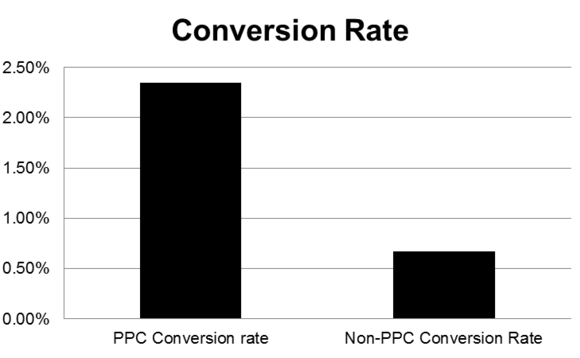Everyone knows that PPC helps to increase sales. After all, PPC almost always drives incremental traffic to a website and some of those visitors are likely to convert. Much was made of Google’s 2011 Search Ads Pause study, which showed that 89 percent of site visits were incremental to organic results.
It’s important to keep in mind, though, that Google’s study focused on site visits, not sales. Most assume that more visits mean more sales and that fewer visits mean fewer sales. However, not all visits are created equal.
This case study illustrates the true value of PPC visits.
The Situation
The advertiser in this study is a B2B ecommerce advertiser. Let’s say they sell widgets to businesses via their website. The advertiser recently launched a new site and wanted to test using PPC to boost sales. The test lasted 10 weeks.
Before we jump into details, let’s revisit the current search landscape. Here’s a good example of an ecommerce SERP. The product isn’t what the advertiser in this case sells, but it’s a good approximation of what their SERPs look like.

About 80 percent of screen real estate above the fold is dedicated to ads, including shopping results from numerous competitors. Let’s face it – this is not an easy space to play in for any ecommerce advertiser. Multiple sellers often sell the same thing, frequently at different prices. PPC is almost a must in order to appear above the fold.
During the test, the advertiser bid on brand and non-brand terms. While brand terms usually perform better than non-brand, it’s important to bid on brand terms anyway, especially in a competitive ecommerce environment where competitors may be bidding on your brand name.
So what did results look like?
Both Traffic and Sales Increased
With PPC, site visits increased by 17 percent. No surprise there.
The surprising fact was that sales increased by a whopping 136 percent with PPC.

Now, this data is for all visitors & sales, not just those from PPC. One may think that the increase came from other channels, as well as from PPC. In this case, the advertiser was indeed doing other marketing. Few marketers use only one advertising channel at any given time.
This is where attribution comes in.
Attribution, in a nutshell, is data that shows all the channels a customer used to access your website before making a purchase. B2B buyers, in particular, frequently make multiple visits to a website before purchasing. They might find out about you from a PPC ad and browse, but not buy. They might return later from an organic search and sign up for your e-newsletter, and then return to buy via an email. That’s three touches from three different channels.
PPC often influences other marketing. It’s frequently the impetus that gets potential buyers’ attention.
Buyers Touched by PPC Were More Valuable Than Those Not Touched by PPC
Because attribution is so important, we analyzed it for this advertiser. We found that purchases that were touched at some point by PPC had a 21 percent higher average sale than those not influenced by PPC.

Clearly, using PPC resulted in higher-value orders in this case. When analyzing the impact of PPC, it’s important to look not only at total conversions, but conversion value as well. You may find that PPC is driving more valuable customers than other channels.
At the end of the test, the advertiser turned off their PPC campaigns to evaluate the results of the test and reassess their overall marketing strategy. The results after the shutdown of PPC are telling.
Interestingly, total site visitors held steady after PPC was paused. There could be many reasons for this: perhaps PPC increased awareness and people sought out the site from other channels. Those searching on brand names likely came to the site from organic listings. Seasonality could also play a role.
With visitors holding steady, one may assume that sales held steady, also. Not so.
Sales Dropped When PPC was Paused
Both total orders and conversion rate fell off when PPC was paused.

That’s right: both online orders and buyers per visitor (conversion rate) fell by 23 percent when PPC was paused, even though total visitors stayed the same.
Why?
If a visitor is a visitor, regardless of source, why did sales fall off? Shouldn’t we assume that traffic would decrease when PPC stops, and if it doesn’t, that sales would hold steady?
No.
The reason for the decrease in sales boils down to conversion rate. If you look closely at the chart above, you’ll notice that overall conversion rates on the website were very low – below 1 percent. Let’s take a deeper look at conversion rate by source.

That picture tells the whole story, really. PPC conversion rate was 2.25 percent, so it wasn’t bad, although for ecommerce it could have been better, but the conversion rate on the rest of the traffic was barely above 0.50 percent. More than 99 out of 100 non-PPC visitors did not purchase. PPC traffic converted 3.5 times better than non-PPC traffic. There’s the impact of PPC.
Takeaways
So what can we learn from this test?
- The ecommerce SERPs are dominated by paid placements, so PPC is important.
- PPC can increase site visitors, but more importantly, increase sales.
- PPC visitors are more valuable than non-PPC visitors from a revenue-per-sale standpoint.
- PPC visitors convert better.
Have you tried pausing PPC ads to gauge the impact on visitors and sales? What happened? Share in the comments!


